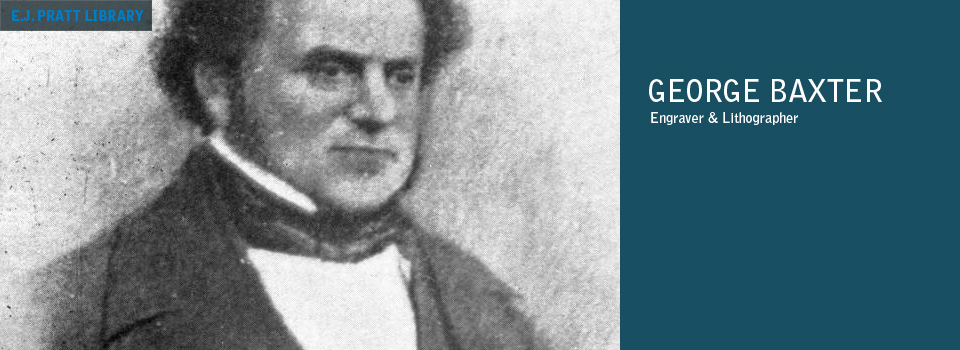George Baxter
Biography
George Baxter (1804 - 1867), who was trained as a lithographer and engraver, developed a process to produce colour prints from blocks and plates using oil-based inks. His aim was to provide good, inexpensive prints for popular sale and to imitate oil painting. He said of his prints, "that while their artistic beauty may procure for them a place in the Royal palaces throughout Europe, the prices at which they are retailed introduces them to the humblest cottages."
He was the first printer successfully to use oil-based inks. He first began to print with a succession of wood blocks, but later used metal plates as well, often printing the basic design from a steel engraving. In many cases aquatint, mezzotint, and even lithograph were introduced into the process, some prints requiring over thirty blocks. The press-work at Baxter's establishment must have been superb in order to keep so many impressions in perfect register. It seems particularly remarkable when one learns that he used Stanhope and Cogger presses, machines already outdated by some thirty years at the time he was using them.
Baxter described his process in the patent specification:
My invention consists in colouring such impressions of steel and copper plate engravings and lithographic and zincographic printing by means of block printing in place of colouring such impressions by hand as heretofore practised, and which is an expensive process; and by such a process producing coloured impressions of a high degree of perfection and far superior in appearance to those which are coloured by hand and such prints as are obtained by means of block printing in various colours uncombined with copper and steel lithographic or zincographic impressions.
In order to produce a number or ornamental prints resembling a highly-coloured painting, whether in oil or water colours according to my invention, I proceed first to have the design engraved on a copper or steel plate. ...By thus colouring such descriptions of impressions the result will be that the prints produced will be more exquisite in their finish, more correct in their outline, and more soft and mellow in their appearance.
Unfortunately the process was much less a commercial than an artistic success, and Baxter was constantly in debt. In 1849 he applied, pleading poverty and debt, to have his patent extended. Although the application was opposed by George Leighton, an old pupil of Baxter's, the extension was granted. In giving judgement, Lord Brougham advised Baxter to grant licences, he said that the process was of "public utility," but seemed sorry that the public benefited more than Baxter:
It is a pleasure to them, and now it is made a cheap pleasure. It is a very innocent pleasure to them, and far more innocent than many other pleasures to which they are used to have recourse, and far more refined. It is of an improving nature to their minds, and whatever works tend to give taste of a refined and intellectual nature to the working people are of very great benefit, nor merely to their happiness but to their morals and their good conduct in society. Therefore their Lordships are of opinion that it is a valuable invention in every sense. It has not, however, been valuable to the patentee.
Baxter retired from active business in 1860, but the sale of his prints and materials was a failure and much of the material was bought in by the auctioneer. He began to republish his prints late in 1864 or early in 1865. Later in 1865 he became bankrupt. On January 11, 1867, Baxter died as the result of injuries received in an omnibus accident. After his death his prints were published as Baxter Prints by Vincent Brooks, Day & Son and as their own by Le Blond & Co., his licencees.

Baxter Licensee Prints in the Victoria University Library
Full List of Baxter Prints at Victoria University Library Starr Collection: Note: Numbers are the catalogue numbers of the prints in the collection.
LeBlond Prints in the Victoria University Library
Le Blond Prints at Victoria University Library. Abraham Le Blond (1819-1894) became the first Baxter licensee in 1849.
The Le Blond Ovals at Victoria University Library
Related Exhibitions at Victoria University Library
Virtual exhibitions of George Baxter prints highlighting
the Library's
Starr Collection of Baxter Prints:
George Baxter (1804-1867): A Bicentenary Exhibition of Prints and llustrations
Colour Prints by George Baxter (1804 - 1867)
Related Resources
Baxter Colour Prints; Pictorially Presented / Harold George Clarke
George Baxter, His Life and Work, a Manual for Collectors. / C. T. Courtney Lewis
The World in Color by George Baxter/ Hugh Edwards. Bulletin of the Art Institute of Chicago Vol.42, No.4 (Apr.- May,1948), pp.47-50.
The New Baxter Society Formed in 1983 to further interest in the work of George Baxter.
Color
Printing in the Nineteenth Century (See "Relief Processes")
An Exhibition at the Hugh M. Morris Library University of Delaware Library
